4. Ethernet Virtual Private Networks
This chapter provides information about Ethernet Virtual Private Networks (EVPN) for 7210 SAS-K 2F6C4T and 7210 SAS-K 3SFP+ 8C.
4.1. EVPN Applications
EVPN can be used as the control plane for different data plane encapsulations. The Nokia implementation supports EVPN for MPLS tunnels (EVPN-MPLS), where PEs are connected by any type of MPLS tunnel. EVPN-MPLS is generally used as an evolution for VPLS services. The EVPN-MPLS functionality is standardized in RFC 7432.
4.1.1. EVPN for MPLS Tunnels in E-LAN Services
Figure 42: EVPN for MPLS in VPLS Services
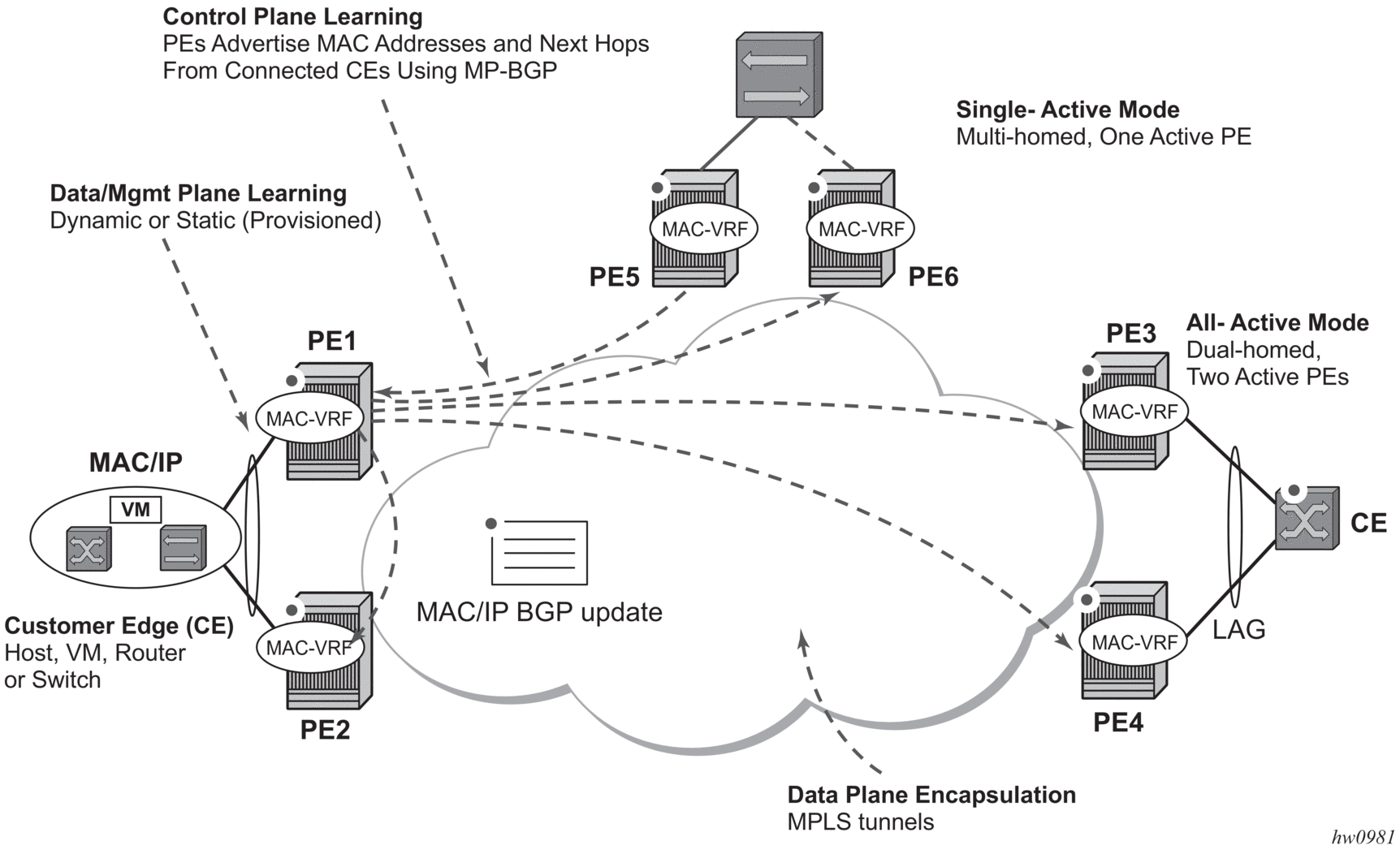
EVPN technology provides significant benefits, including:
- IP-VPN-like operation and control for E-LAN services
- reduction and (in some cases) suppression of the broadcast, unknown unicast, and multicast (BUM) traffic in the network
- simple provision and management
- new set of tools to control the distribution of MAC addresses and ARP entries in the network
The SR OS EVPN-MPLS implementation is compliant with RFC 7432.
4.2. EVPN for MPLS Tunnels
This section provides information about EVPN for MPLS tunnels (EVPN-MPLS).
4.2.1. BGP-EVPN Control Plane for MPLS Tunnels
Table 34 lists all the EVPN routes supported in 7210 SAS SR OS and their usage in EVPN-MPLS.
Table 34: EVPN Routes and Usage
EVPN Route | Usage | EVPN-MPLS |
Type 1 — Ethernet auto-discovery route (A-D) | Mass-withdraw, ESI labels, Aliasing | Yes |
Type 2 — MAC/IP advertisement route | MAC/IP advertisement, IP advertisement for ARP resolution | Yes |
Type 3 — Inclusive multicast Ethernet Tag route | Flooding tree setup (BUM flooding) | Yes |
Type 4 — Ethernet segment (ES) route | ES discovery and DF election | Yes |
RFC 7432 describes the BGP-EVPN control plane for MPLS tunnels. If EVPN multi-homing is not required, two route types are needed to set up a basic EVPN Instance (EVI): MAC/IP Advertisement and the Inclusive Multicast Ethernet Tag routes. If multi-homing is required, the ES and the Auto-Discovery routes are also needed.

Note:
- IP address and IP address length
- MPLS Label 2
Figure 43: EVPN Routes Type 1 and 4
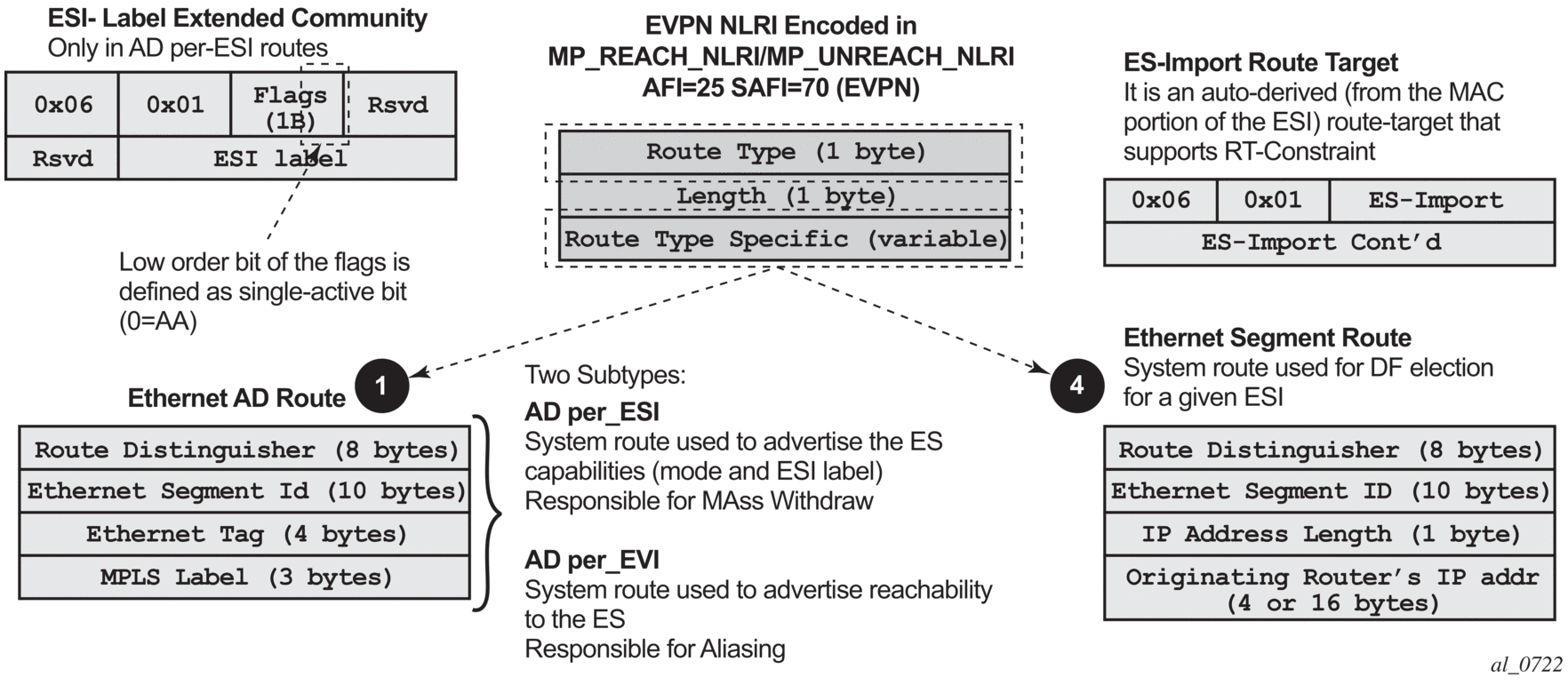
- Ethernet AD route per-ESI
- Ethernet AD route per-EVI
The Ethernet AD per-ESI route generated by a router uses the following fields and values:
- MPLS label
The system can send only a separate Ethernet AD per-ESI route per service.
The Ethernet AD per-EVI route generated by a router uses the following fields and values:
| Note: The AD per-EVI route is not sent with the ESI label Extended Community. |
EVPN Route Type 4 — ES route
The router generates this route type for multi-homing ES discovery and DF (Designated Forwarder) election.
RFC 5512 — BGP Tunnel Encapsulation Extended Community
The following routes are sent with the RFC 5512 BGP Encapsulation Extended Community: MAC/IP, Inclusive Multicast Ethernet Tag, and AD per-EVI routes. ES and AD per-ESI routes are not sent with this Extended Community.
4.2.2. EVPN for MPLS Tunnels in VPLS Services
| Note: The EVI and the system IP must be configured before executing the configure>service/vpls>bgp-evpn>mpls>no shutdown command. |
- the route-distinguisher is derived from: system_ip:evi
- the route-target is derived from: autonomous-system:evi
| Note: |
When the evi command is configured, a config>service>vpls>bgp node (even empty) is required to output correct information using the show service id 1 bgp and show service system bgp-route-distinguisher commands.
The following options are specific to EVPN-MPLS and are configured in the config>service>vpls>bgp-evpn>mpls context:
- control-wordEnable or disable control-word to guarantee interoperability to other vendors. In accordance with RFC 7432, this command is required to avoid frame disordering.
- auto-bind-tunnelThis command is used to select the type of MPLS transport tunnel used for a specific instance. The command is used in the same way as in VPRN services. See auto-bind-tunnel for more information.For BGP-EVPN MPLS, bgp must be explicitly added to the resolution-filter in EVPN (BGP is implicit in VPRNs).
- force-vlan-vc-forwarding
- split-horizon-group
- ecmpWhen this command is set to a value greater than 1, aliasing is activated to the remote PEs that are defined in the same all-active multi-homing ES. See EVPN All-Active Multi-Homing for more information.
- ingress-replication-bum-label
In addition to the preceding options, the following bgp-evpn commands are also available for EVPN-MPLS services:
- [no] mac-advertisement
- mac-duplication and settings
When EVPN-MPLS is established among some PEs in the network, EVPN unicast and multicast “bindings” to the remote EVPN destinations are created on each PE. A specified ingress PE creates the following:
4.2.2.1. EVPN and VPLS Integration
In accordance with draft-ietf-bess-evpn-vpls-seamless-integ, the 7210 SAS EVPN implementation allows EVPN-MPLS and VPLS to be integrated to the same network within the same service. Because EVPN is not deployed in green-field networks, this feature is useful for facilitating the integration between both technologies and for migrating VPLS services to EVPN-MPLS.
The following behavior enables the integration of EVPN and SDP-bindings in the same VPLS network.
Figure 44 shows an example of EVPN-VPLS integration.
Figure 44: EVPN-VPLS Integration
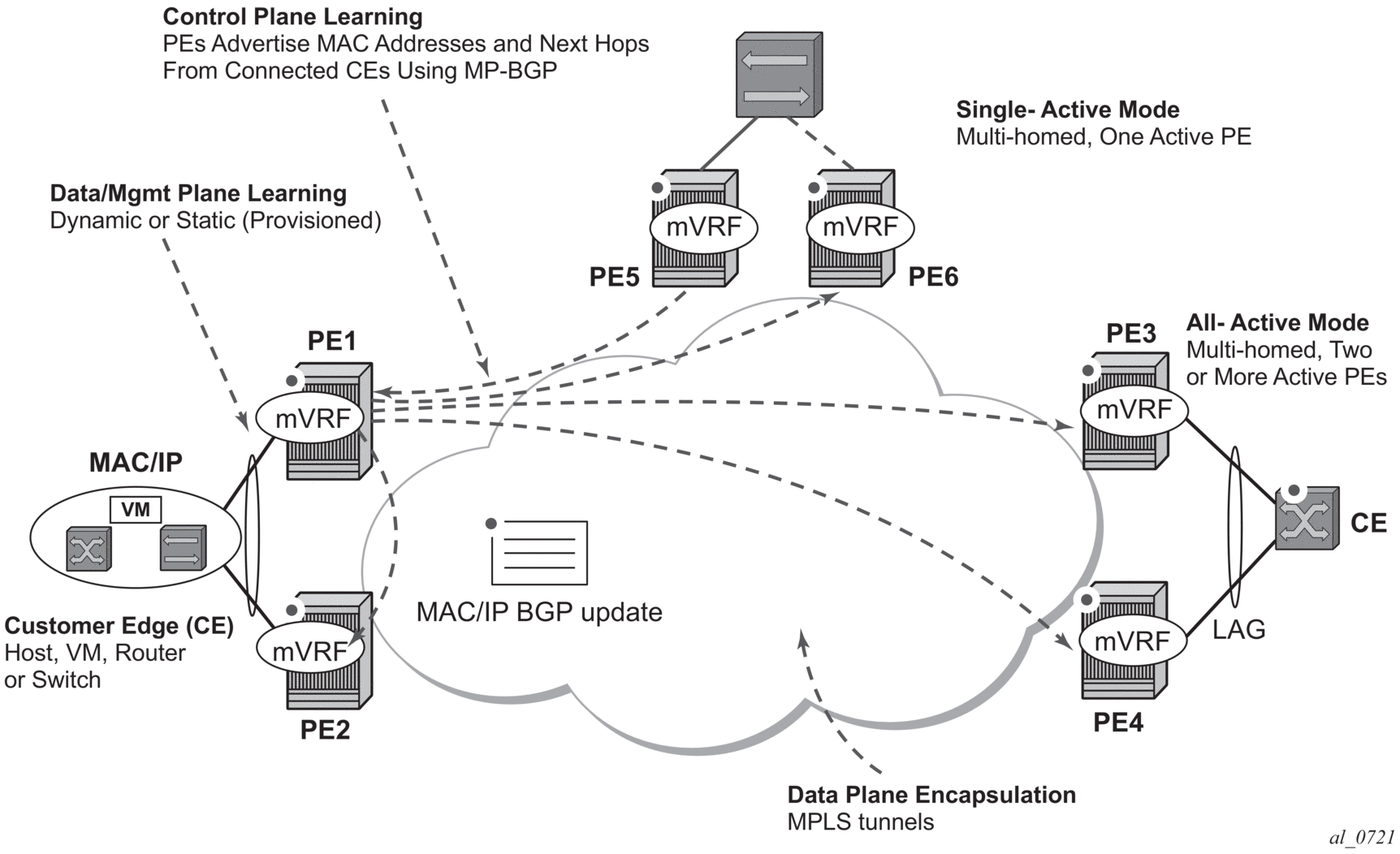
The following is a sample configuration output of PE1, PE5, and PE2.
The following applies to the configuration described in the preceding example.
- PE1, PE3, and PE4 have BGP-EVPN and BGP-AD enabled in VPLS-1. PE5 has BGP-AD enabled and PE2 has active/standby spoke-SDPs to PE1 and PE5. In this configuration:
- Manual spoke-SDPs from PE1 and PE5 to PE2 are not part of SHG-1.
- MACs learned on FEC128 spoke-SDPs are advertised normally in EVPN.
4.2.2.2. Auto-Derived RD in Services with Multiple BGP Families
The following rules apply.
- if no manual-rd configuration, the RD is derived from the bgp-ad>vpls-id

Note: When the RD changes, the active routes for that VPLS are withdrawn and re-advertised with the new RD.

Note: - Because the vpls-id takes precedence over the evi when the RD is auto-derived, the existing RD is not affected when evpn is added to an existing bgp-ad service. This is important to support bgp-ad to evpn migration.
4.2.3. EVPN Multi-Homing in VPLS Services
Each ES has a unique Ethernet Segment Identifier (ESI) that is 10 bytes long and is manually configured in the router.
| Note: Because the esi command is advertised in the control plane to all the PEs in the EVPN network, it is important to ensure that the 10-byte esi value is unique throughout the entire network. Single-homed CEs are assumed to be connected to an ES with esi = 0 (single-homed ESs are not explicitly configured). |
4.2.4. EVPN All-Active Multi-Homing
In accordance with RFC 7432, all-active multi-homing is only supported on access LAG SAPs, and it is mandatory to configure the CE with a LAG to avoid duplicated packets to the network. LACP is optional.
4.2.4.1. All-Active Multi-Homing Procedures
| Note: The 7210 SAS only supports two PEs per ES for all-active multi-homing. |
4.2.4.1.1. Designated Forwarder Election
Figure 45 shows the need for DF election in all-active multi-homing.
Figure 45: DF Election

| Note: BUM traffic from the CE to the network and known unicast traffic in any direction is allowed on both the DF and non-DF PEs. |
4.2.4.1.2. Split-Horizon
The EVPN split-horizon procedure ensures that BUM traffic originated by the multi-homed PE and sent from the non-DF to the DF is not replicated back to the CE in the form of echoed packets. To avoid echoed packets, the non-DF (PE1) sends all the BUM packets to the DF (PE2) with an indication of the source ES. That indication is the ESI Label (ESI2 in Figure 46), previously signaled by PE2 in the AD per-ESI route for the ES. When it receives an EVPN packet (after the EVPN label lookup), PE2 finds the ESI label that identifies its local ES ESI2. The BUM packet is replicated to other local CEs but not to the ESI2 SAP.
Figure 46 shows the EVPN split-horizon concept for all-active multi-homing.
Figure 46: Split-Horizon

4.2.4.1.3. Aliasing
Figure 47 shows the EVPN aliasing procedure for all-active multi-homing. Because CE2 is multi-homed to PE1 and PE2 using an all-active ES, “aliasing” is the procedure by which PE3 can load-balance the known unicast traffic between PE1 and PE2, even if the destination MAC address is only advertised by PE1.
Figure 47: Aliasing
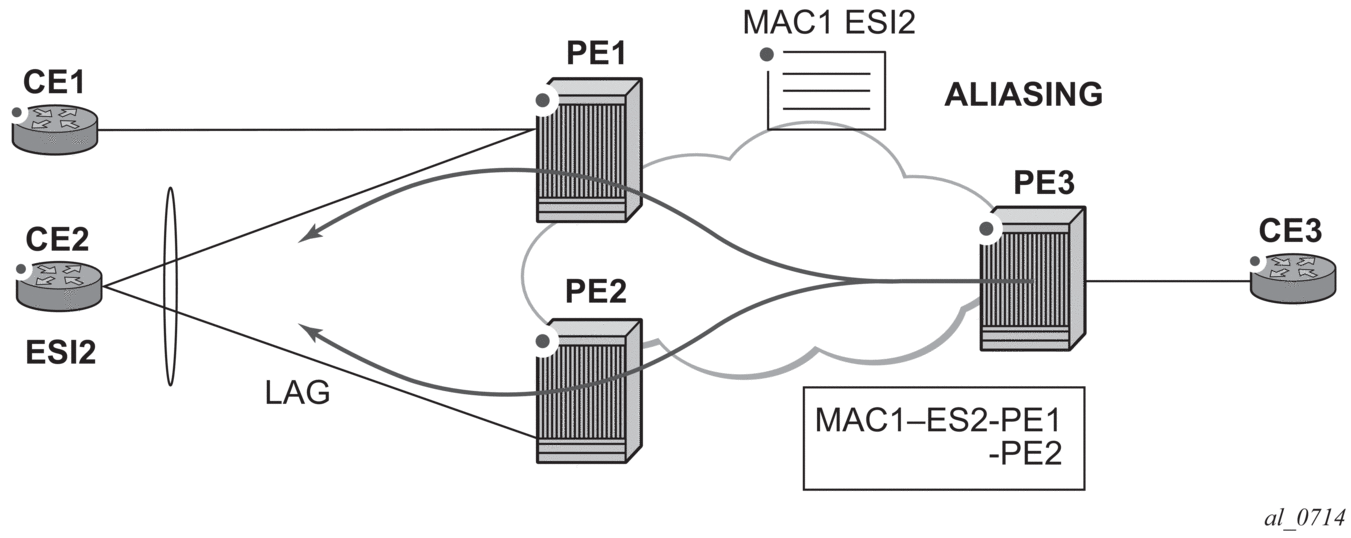
4.2.4.2. All-Active Multi-Homing Service Model
The following is a sample output of the PE1 configuration that provides all-active multi-homing to the CE2 shown in Figure 47.
In the same way, PE2 is configured as follows:
The following considerations apply when the all-active multi-homing procedure is enabled.
- The ethernet-segment command must be configured with a name and a 10-byte esi using the config service system bgp-evpn ethernet-segment es_name create and config service system bgp-evpn ethernet-segment esi value commands.
- When configuring the esi, the system enforces that the 6 high-order octets after the type are not zero, which ensures that the auto-derived route-target for the ES route is not zero). In addition, the entire ESI value must be unique in the system.
- Only a LAG can be associated with the all-active ES. LAG is used exclusively for EVPN multi-homing. Other LAG ports in the system can continue to be used for MC-LAG and other services.
- When the LAG is configured on PE1 and PE2, the same admin-key, system-priority, and system-id must be configured on both PEs so that CE2 can respond as though it is connected to the same system.
- Only one SAP per service can be part of the same ethernet-segment.
4.2.4.3. ES Discovery and DF Election Procedures
Figure 48: ES Discovery and DF Election
df_election.gif)
Step 1 — ES Advertisement and Discovery
In addition to the ES route, PE1 and PE2 advertise AD per-ESI routes and AD per-EVI routes.
- AD per-EVI routes are advertised so that PE3 knows what services (EVIs) are associated with the ESI. These routes are used by PE3 for its aliasing and backup procedures.
Step 2 — DF Election
When ES routes exchange between PE1 and PE2 is complete, both run the DF election for all the services in the ethernet-segment.
- The local IP can only be considered a “candidate” after successful ethernet-segment no shutdown for a specified service.

Note: The remote PE IPs must be present in the local PE RTM so that they can participate in the DF election.
- An es-activation-timer can be configured at the redundancy>bgp-evpn-multi-homing>es-activation-timer level or at the service>system>bgp-evpn>eth-seg>es-activation-timer level. This timer, which is 3 seconds by default, delays the transition from non-DF to DF for a specified service after the DF election has run.
- This use of the es-activation-timer is different from zero and minimizes the risks of loops and packet duplication due to “transient” multiple DFs.
- The same es-activation-timer should be configured in all PEs that are part of the same ESI. It is up to the user to configure either a long timer to minimize the risks of loops/duplication or even es-activation-timer=0 to speed up the convergence for non-DF to DF transitions. When the user configures a specific value, the value configured at the ES level supersedes the configured global value.
- The DF election is triggered by the following events.
- The config service system bgp-evpn eth-seg no shutdown command triggers the DF election for all the services in the ESI.
- Reception of a new update of an AD per-ES route with a change in the ESI-label extended community (single-active bit or MPLS label) triggers the DF election for all the services associated with the list of route-targets received along with the route.

Note:
- If a range is configured but service-carving is not mode manual, the range has no effect.
- Only two PEs are supported when service-carving mode manual is configured. If manual mode is configured for a third PE for an ESI, the two non-primary PEs remain non-DF regardless of the primary status.
Step 3 — DF and Non-DF Service Behavior
4.2.4.4. Aliasing
| Note: mac 00:ca:ca:ba:ce:03 is associated with the ethernet-segment eES:01:00:00:00:00:71:00:00:00:01 (esi configured on PE1 and PE2 for ESI-1). |
| Note: The ethernet-segment eES:01:00:00:00:00:71:00:00:00:01 is resolved to PE1 and PE2 addresses. |
4.2.4.5. Network Failures and Convergence for All-Active Multi-Homing
Figure 49 shows the behavior on the remote PEs (PE3) when there is an ethernet-segment failure.
Figure 49: All-Active Multi-Homing ES Failure
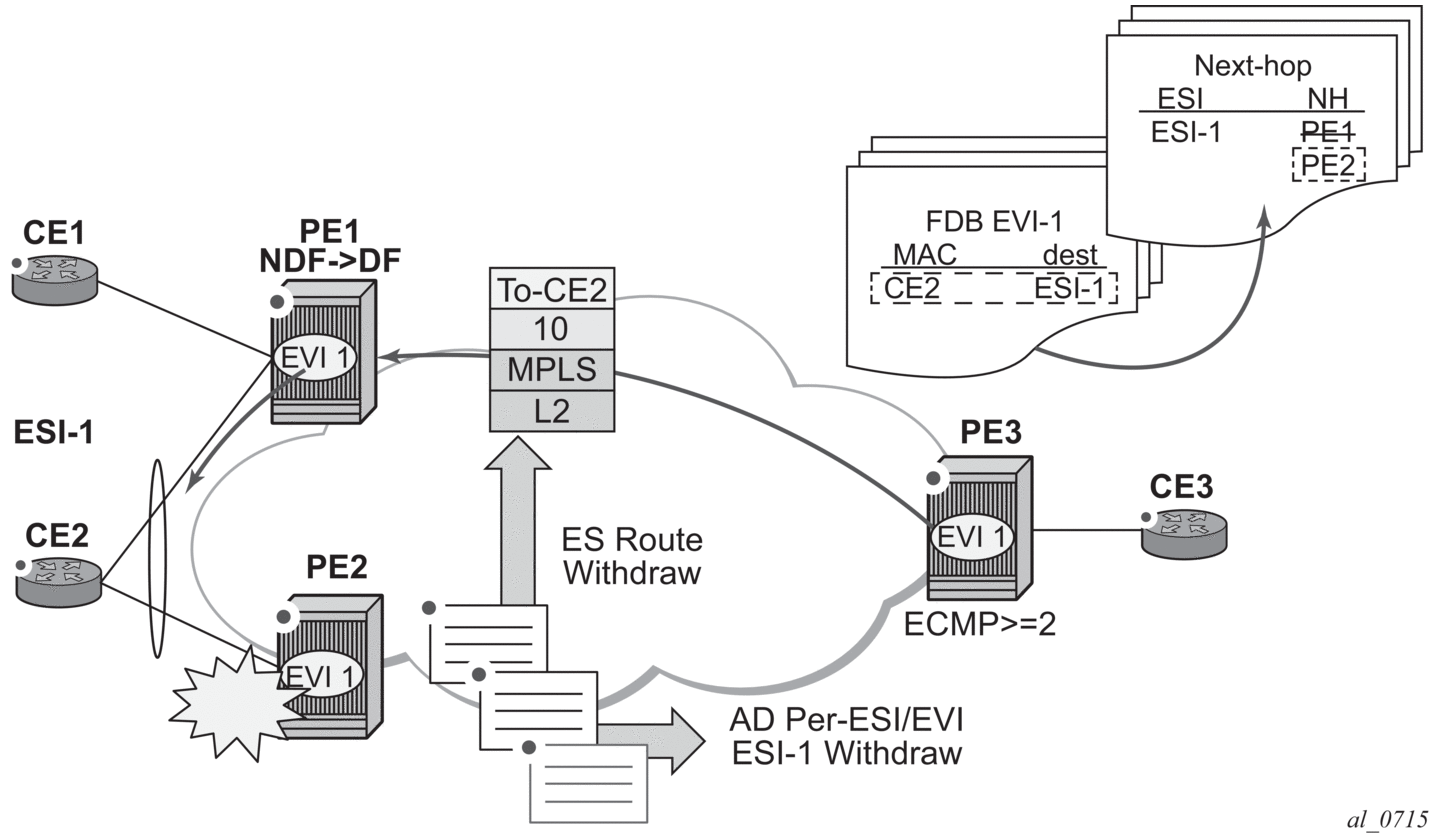
The following steps describe the unicast traffic behavior on PE3.
- PE3 can only forward MAC DA = CE2 to both PE1 and PE2 when the MAC advertisement route from PE1 (or PE2) and the set of Ethernet AD per-ES routes and Ethernet AD per-EVI routes from PE1 and PE2 are active at PE3.
- reception of ES route update (local ES shutdown/no shutdown or remote route)
- new AD-ES route update/withdraw
- new AD-EVI route update/withdraw
- local ES port/SAP/service shutdown
- service carving range change (affecting the EVI)
- multi-homing mode change (single/all active to all/single-active)
4.2.4.6. Logical Failures on ESs and Blackholes
Specific “failure scenarios” in the network can trigger effects. Figure 50 shows some of these scenarios.
Figure 50: Blackhole Caused by SAP/SVC Shutdown

The same result occurs if the ES SAP is administratively shutdown instead of the service.
| Note: |
4.2.4.7. Transient Issues Due to MAC Route Delays
Figure 51 shows scenarios that may cause potential transient issues in the network.
Figure 51: Transient Issues Caused by “slow” MAC Learning

In Figure 51, the scenario on the left shows an example of transient packet duplication caused by delay in PE3 to learn MAC1.
| Note: |
In Figure 51, the scenario on the right shows an example of transient blackhole caused by delay in PE1 to learn MAC1.
| Note: This is a transient issue that is resolved as soon as MAC1 is learned in PE1 and the frames are forwarded as known unicast. |
4.2.5. EVPN Single-Active Multi-Homing
The following SR OS procedures support EVPN single-active multi-homing for a specified ES:
- DF electionThe DF election in single-active multi-homing determines the forwarding for BUM traffic from the EVPN network to the ES CE. DF election also determines the forwarding of any traffic (unicast or BUM) in any direction (to or from the CE).
- backup PE
Figure 52: Backup PE
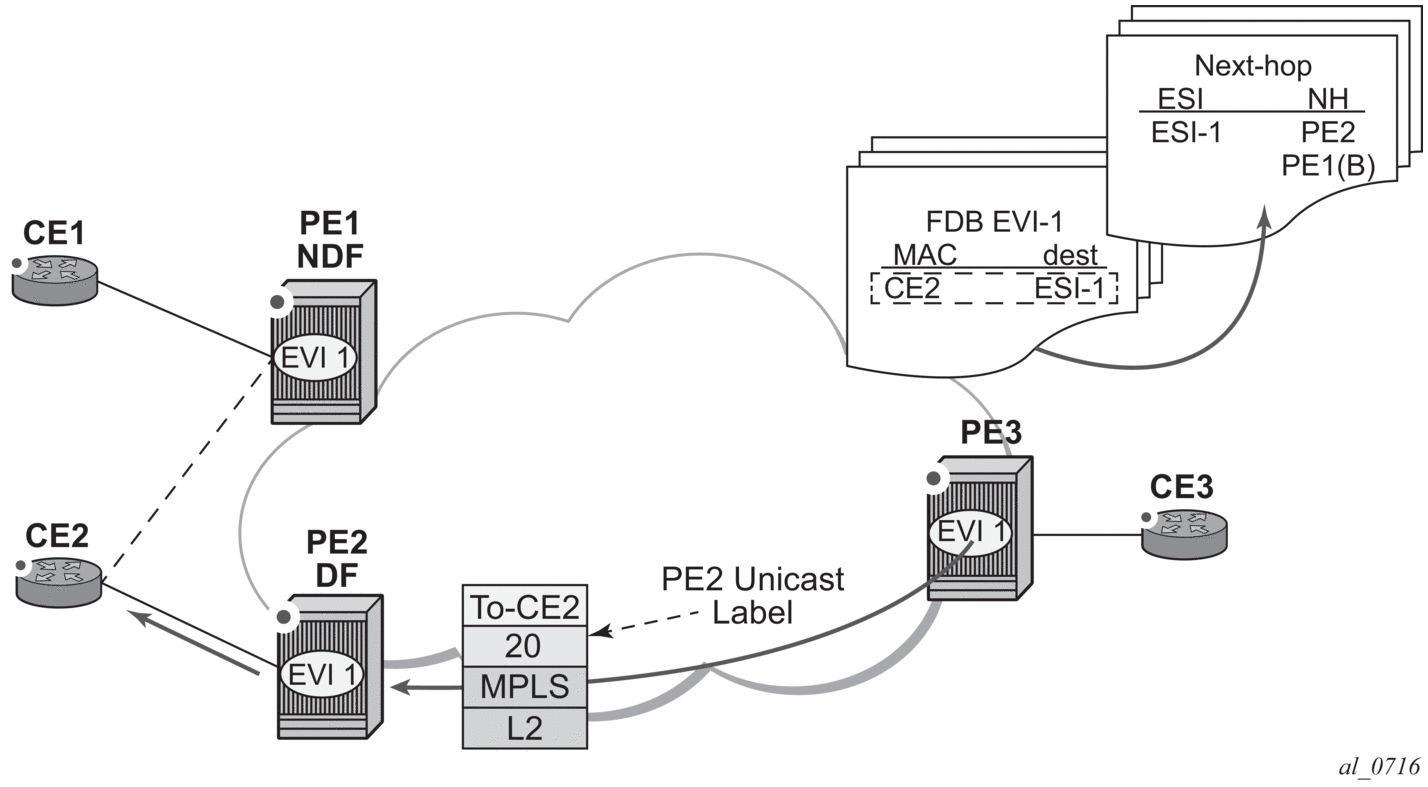
4.2.5.1. Single-Active Multi-Homing Service Model
The following example shows a PE1 configuration that provides single-active multi-homing to CE2, as shown in Figure 52.
- The advertisement of the ESI-label in an AD per-ESI is optional for single-active ESs. Use the service system bgp-evpn eth-seg multi-homing single-active no-esi-label command to control the ESI label advertisement. By default, the ESI label is also used for single-active ESs.

Note:
- LAG with or without LACP
- regular Ethernet 802.1q/ad ports
4.2.5.2. ES and DF Election Procedures
4.2.5.3. Backup PE Function
| Note: |
4.2.5.4. Network Failures and Convergence for Single-Active Multi-Homing
Figure 53 shows an example of remote PE (PE3) behavior when there is an ethernet-segment failure.
Figure 53: Single-Active Multi-Homing ES Failure
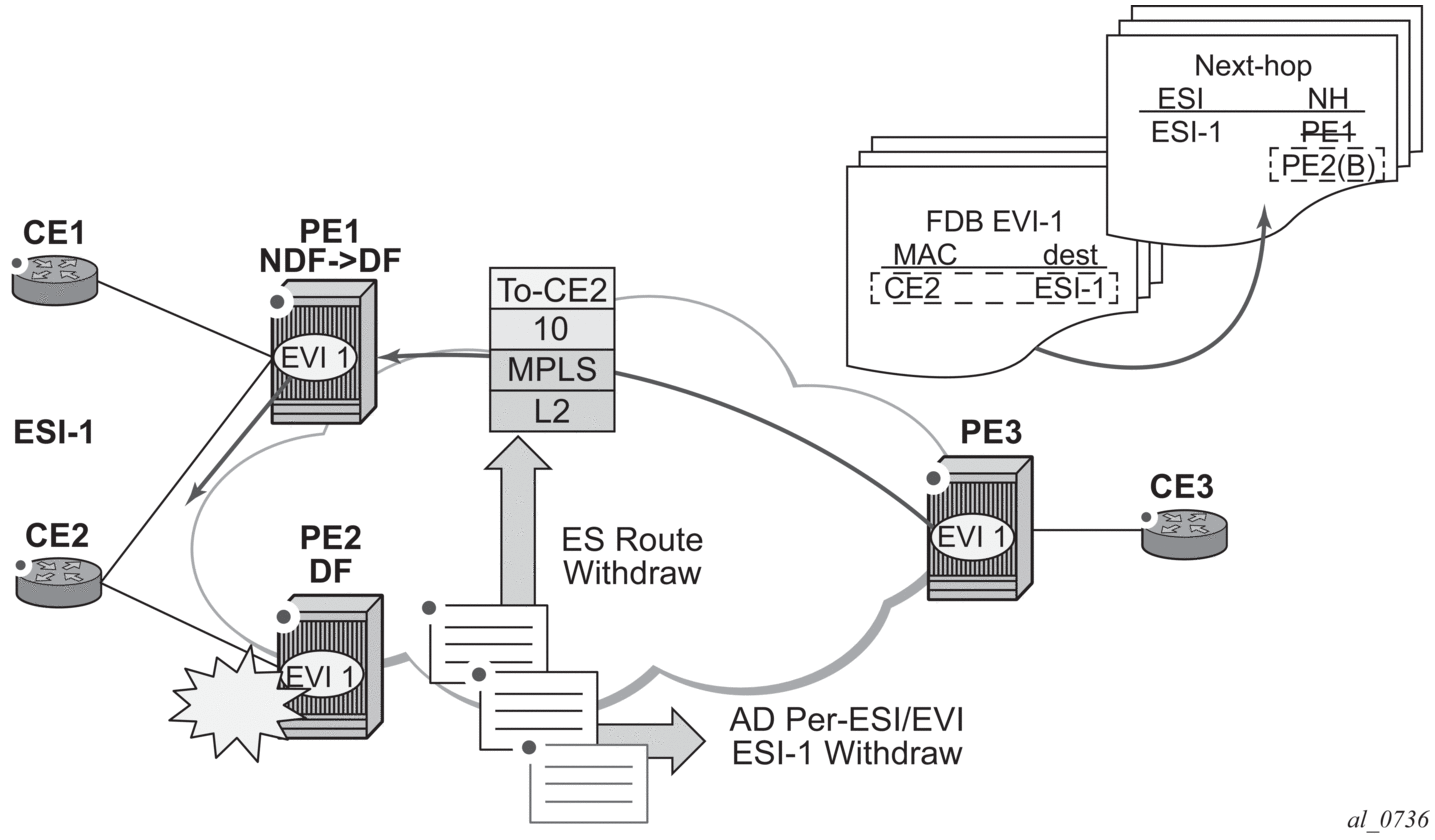
The following steps list the behavior of the remote PE3 for unicast traffic.
4.3. General EVPN Topics
| Note: |
4.3.1. ARP and ND Snooping and Proxy Support
In addition, any ingress ARP or ND frame on a SAP or SDP-binding are intercepted and processed. The system answers ARP requests and Neighbor Solicitation messages if the requested IP address is present in the proxy table.
Figure 54: Proxy-ARP Example Usage in an EVPN Network
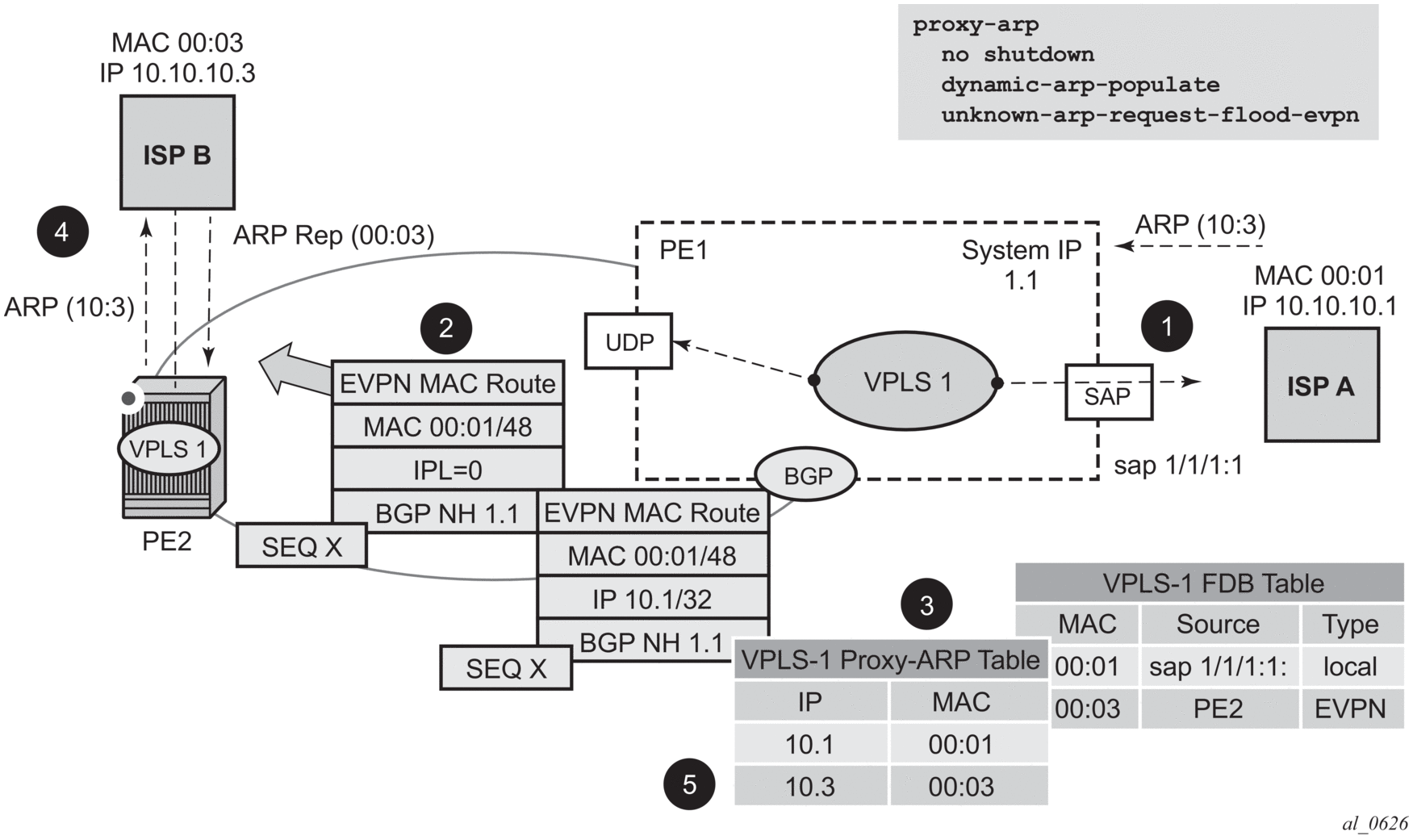
In Figure 54, PE1 is configured as follows:
Figure 54 shows the following steps, assuming proxy-ARP is no shutdown on PE1 and PE2, and the tables are empty.
- ISP-A sends ARP-request for 10.10.10.3.
- Assuming PE1 was configured with unknown-arp-request-flood-evpn, the ARP-request is flooded to PE2 and delivered to ISP-B. ISP-B replies with its MAC in the ARP-reply. The ARP-reply is finally delivered to ISP-A.
From this point onward, the PEs reply to any ARP-request for 00:01 or 00:03 without the need for flooding the message in the EVPN network. By replying to known ARP-requests and Neighbor Solicitations, the PEs help to significantly reduce the flooding in the network.
Use the following commands to customize proxy-ARP/proxy-ND behavior:
- dynamic-arp-populate and dynamic-nd-populate
- static ipv4-address mac-address, static ipv4-address mac-address, and static ipv6-address mac-address {host | router}These commands configure static entries to be added to the table.

Note: - age-time seconds
- send-refresh seconds
- table-size table-sizeThis command enables the user to limit the number of entries learned on a specified service. By default, the table-size limit is 250.
- proxy-arp [no] unknown-arp-request-flood-evpn
- proxy-arp [no] garp-flood-evpn
- proxy-nd [no] unknown-ns-flood-evpn
- proxy-nd [no] host-unsolicited-na-flood-evpn
- proxy-nd [no] router-unsolicited-na-flood-evpn
- dup-detect [anti-spoof-mac mac-address] window minutes num-moves count hold-down minutes | maxThis command enables a mechanism that detects duplicate IPs and ARP/ND spoofing attacks. The following is a summary of the dup-detect command mechanism.
- The condition is cleared when hold-down time expires (max does not expire) or a clear command is issued.
| Note: A static entry is active in the FDB even when the service is down. |
Table 35: Proxy-ARP Entry Combinations
FDB Entry Type (for the same MAC) | |
Dynamic | learned |
Static | learned |
Dynamic | CStatic/Static |
Static | CStatic/Static |
EVPN | EVPN, learned/CStatic/Static with matching ESI |
Duplicate | — |
4.3.1.1. Proxy-ARP/ND Periodic Refresh, Unsolicited Refresh, and Confirm-Messages
- periodic refresh messages (ARP-requests or NS for a specified IP)
- unsolicited refresh messages (unsolicited GARP or NA messages)These messages are sent by the system when a new entry is learned or updated. Their objective is to update the attached host/router caches.
- confirm messages (unicast ARP-requests or unicast NS messages)
4.3.1.2. Proxy-ND and the Router Flag in Neighbor Advertisement Messages
RFC 4861 describes the use of the (R) or “Router” flag in NA messages as follows:
- a node capable of routing IPv6 packets must reply to NS messages with NA messages where the R flag is set (R=1)
- hosts must reply with NA messages where R=0
4.3.1.3. Procedure to Add the R Flag to a Specified Entry
The procedure to add the R flag to a specified entry is as follows.
- Dynamic entries are learned based on received NA messages. The R flag is also learned and added to the proxy-ND entry so that the appropriate R flag is used in response to NS requests for a specified IP.
- Static entries are configured as host or router as per the [no] static ip-address ieee-address {host | router} command.
- EVPN entries are learned from BGP and the evpn-nd-advertise {host | router} the R flag added to them.
4.3.2. BGP-EVPN MAC Mobility
- The router honors and generates the Sequence (SEQ) number in the MAC mobility extended community for MAC moves.
- A SEQ number = zero or no mac mobility ext-community are interpreted as sequence zero.
- In case of mobility, the following MAC selection procedure is followed.
- If a PE has two or more active remote EVPN routes for the same MAC, the highest SEQ number is selected. The tie-breaker is the lowest IP (BGP NH IP).
- If a PE has two or more active EVPN routes and it is the originator of one of them, the highest SEQ number is selected. The tie-breaker is the lowest IP (BGP NH IP of the remote route is compared to the local system address).
| Note: When EVPN multi-homing is used in EVPN-MPLS, the ESI is compared to determine whether a MAC received from two different PEs should be processed within the context of MAC mobility or multi-homing. Two MAC routes that are associated with the same remote or local ESI but different PEs are considered reachable through all those PEs. Mobility procedures are not triggered if the MAC route still belongs to the same ESI. |
4.3.3. BGP-EVPN MAC Duplication
| Note: The other routers in the VPLS instance forward the traffic for the duplicate MAC address to the router advertising the best route for the MAC. |
The values of num-moves and window can be configured for different environments. In scenarios where BGP rapid-update EVPN is configured, the operator should configure a shorter window timer than scenarios where BGP updates are sent per the configured min-route-advertisement interval, which is the default.
4.3.4. Conditional Static MAC and Protection
| Note: |
4.3.5. BGP and EVPN Route Selection for EVPN Routes
- EVPN route selection for MAC routes
- conditional static MACs (local protected MACs)
- EVPN static MACs (remote protected MACs)
- data plane learned MACs (regular learning on SAPs/SDP-bindings)
- EVPN MACs with higher SEQ number
- lowest IP (next-hop IP of the EVPN NLRI)
- lowest RD
- BGP route selection for MAC routes with the same route-key
- EVPN static MACs (remote protected MACs)
- EVPN MACs with higher sequence number
- regular BGP selection (local-pref, aigp metric, shortest as-path, …, lowest IP)
| Note: |
4.3.6. Interaction of EVPN and Other Features
This section describes the interaction of EVPN with other features.
4.3.6.1. Interaction of EVPN-MPLS with Existing VPLS Features
- BGP-EVPN is blocked in M-VPLS services; however, a different M-VPLS service can manage a SAP or spoke-SDP in a BGP-EVPN-enabled service.

Note: MAC duplication already provides protection against MAC moves between EVPN and SAPs/SDP-bindings.
- CPE ping is not supported on EVPN services.
- endpoints and attributes
- BPDU translation
- L2PT termination
- MAC-pinning
- IGMP-snooping in VPLS services when BGP-EVPN MPLS is enabled (in the service)
- ETH-CFM (MEPs, vMEPs, MIPs)
4.3.7. Routing Policies for BGP EVPN Routes
- communities (comm-val), extended communities (ext-comm), and large communities (large-comm)
- well-known communities (well-known-comm); no-export | no-export-subconfed | no-advertise
- family EVPN
- BGP attributes that are applicable to EVPN routes (such as AS-path, local-preference, next-hop)